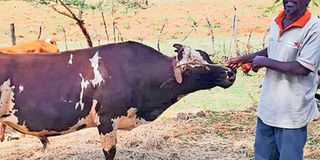Farmer finds formula to grow fodder crops in semi-arid Baringo

David Korir with a bull in his farm in Baringo. He rears cross-breeds for milk production, getting at least 50 litres daily that he sells at Sh30 each. PHOTO | LEOPOLD OBI | NMG
What you need to know:
- Unlike many locals who keep the indigenous cattle breeds, Korir rears the cross-breeds for milk production, getting at least 50 litres daily that he sells at Sh30 each.
- During rainy seasons, he lets grass to grow on the sections of the farm, which he harvests and makes hay.
- Weight of a cow is quite critical while breeding since it helps in avoiding dam-sire mismatch.
Near Lake Baringo sits an expansive pastoral village known as Marigat.
Almost arid, rocky and nestled among acacia trees and dryland shrubs, Marigat has in the past hit the headlines following invasion of Prosopis juliflora (mathenge), a drought-tolerant noxious shrub that claimed lives of hundreds of goats.
Invasion by cattle rustlers who break into homes before driving away with herds of cattle have also been a common phenomenon in the expansive Baringo County.
But amid the threats of desertification, cattle rustling and invasive shrubs, a farmer is overcoming the odds by keeping cross-breed dairy cows and growing his own pasture.
David Korir, 51, owns 12 Guernsey crosses and a bull, four which are lactating.
Unlike many locals who keep the indigenous cattle breeds, Korir rears the cross-breeds for milk production, getting at least 50 litres daily that he sells at Sh30 each.
His land, like the rest in the county, is characterised by rocky outcrops and bushy thickets, which inhibit growth of pasture.
“I had indigenous cattle breeds which grazed in the fields, but when I decided to introduce the cross-breed dairy cows, my biggest worry was where to find fodder,” says the farmer who owns nine acres.
WEIGHT OF COW IS CRITICAL
To get fodder, Korir cut some trees and pruned others to encourage the undergrowth. He learnt of the technique from Kenya Forestry Research Institute (Kefri) and World Vision, under a programme known as Farmer Managed Natural Regeneration project (FMNR).
He cleared the bushes and removed some of the rocks and arranged them elsewhere on the farm.
“Cows are then allowed to graze on the farm in paddocks. As they graze, they drop manure, enhancing the growth of pasture,” he explains.
During rainy seasons, he lets grass to grow on the sections of the farm, which he harvests and makes hay.
He has dug a water pan whose water he uses in irrigating his 60 Kent variety mangoes and pawpaws and watering the animals.
“Sometimes we buy fodder from our neighbour but the bulk we use comes from our farm,” he explains.
Unlike modern day dairy farmers who prefer inseminating their cows with semen from pedigree bulls, the farmer services his cows the conventional way using cross-breed bulls.
“Most of our cows are small-bodied, therefore they cannot be artificially inseminated,” says Korir, adding that once a bull has served the cows, it is later sold to avoid inbreeding.
Felix Opinya, a livestock expert at Egerton University, explains that weight of a cow is quite critical while breeding since it helps in avoiding dam-sire mismatch.
“This means heifers or cows must be served with semen from bulls that matches their weight and sizes to avoid cases of dystocia — overweight or of oversized calves — during calving,” says Opinya.





